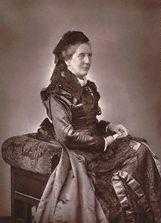Constance Gordon-Cumming

Constance Frederica “Eka” Gordon-Cumming (26 May 1837 – 4 September 1924) was a travel writer and painter. She was born on 26 May 1837 at Altyre, near Forres in Scotland, the 12th child of a wealthy family. Her parents were Sir William Gordon-Cumming, 2nd Baronet, and Elizabeth Maria (Campbell) Cumming. She was the aunt of Sir William Gordon-Cumming, 4th Baronet. She grew up in Northumberland, and was educated at Fulham, London. She taught herself how to paint, and had help from artists visiting her home, including one of Queen Victoria's favorite painters, Sir Edwin Landseer. After spending a year in India in 1867, she became interested in travel.
Gordon-Cumming was a prolific travel writer and landscape painter who traveled the world, mostly in Asia and the Pacific. She painted over a thousand watercolors. Places she visited include Australia, New Zealand, America, China, and Japan. She arrived in Hilo, Hawaii in October 1879, and was among the first artists to paint the active volcanoes.[1] Her Hawaii travelogue, Fire Fountains: The Kingdom of Hawaii, was published in Edinburgh in 1883.[2]
Her best known books are At Home in Fiji and A Lady's Cruise on a French Man-of-War. The latter book resulted from an invitation to join a French ship put into service for the Bishop of Samoa so that he could visit remote parts of his far-flung diocese.
Miss Gordon-Cumming received much criticism from male writers of the era, perhaps because she did not fit in the traditional Victorian role of women, as she often traveled alone and unaided. Henry Adams said her books are a collection of anecdotes without much interest. In any case, her landscape drawings and watercolors seem to be universally admired.
Gordon-Cumming visited Yosemite Valley in April 1878, after visiting Tahiti. She intended to visit for 3 days, but ended up staying 3 months. She says "I for one have wandered far enough over the wide world to know a unique glory when I am blessed by the sight of one . . ." She published her letters back home as Granite Crags in 1884. While in Yosemite Miss Gordon-Cumming also drew watercolor sketches, which she displayed in Yosemite Valley—making it the first art exhibition in Yosemite.
In 1879, while visiting Peking, China, Miss Gordon-Cumming met William Hill Murray, a Scottish missionary to China. He had invented the Numeral Type system, through which blind and illiterate Chinese learned to read and write, by assigning numbers to each of the 408 Chinese Mandarin sounds. Gordon-Cumming wrote a book (1899) about the system and supported the school for the rest of her life. She died in Scotland on 4 September 1924, and is buried near Crieff.
The Honolulu Museum of Art, the Oakland Museum of California and the Yosemite Museum are among the public collections holding works by Constance Gordon-Cumming.[3]
Selected works
-

'Temporary Chimneys and Fire Fountains', watercolor by Constance Gordon-Cumming, c. 1880
-

Indian Life at Mirror Lake (1878) by C. F. G.-C.
-
_-_'Halemaumau'%2C_1879%2C_ink_wash_with_white_heightening_over_traces_of_graphite.jpg)
Halemaumau, 1879, ink wash with white heightening over traces of graphite by Constance Gordon-Cumming, 1879, Honolulu Museum of Art
Publications
| Wikisource has original works written by or about: Constance Frederica Gordon-Cumming |
- 1876 From the Hebrides to the Himalayas; a Sketch of Eighteen Months' Wanderings in Western Isles and Eastern Highlands. (London: Sampson Low, Marston)
- 1881 "The Last King of Tahiti," Contemporary Review, v.41, (London)
- 1881 At Home in Fiji (Edinburgh: William Blackwood)
- 1882 A Lady's Cruise in a French Man-of-War (Edinburgh: William Blackwood & Sons)
- 1882 "Gordon Ningpo and the Buddhist Temples," The Century Magazine (Sept.) (online at Making of America)
- 1883 Fire Fountains: The Kingdom of Hawaii (Edinburgh: William Blackwood)
- 1883 In the Hebrides (Edinburgh). Cruising the Scottish Islands.
- 1884 "Fijian Pottery," The Art Journal
- 1884 Granite Crags Edinburgh and London: William Blackwood & Sons). Reprinted in 1886 and 1888 as Granite Crags of California, minus 2 illustrations
- 1884 In the Himalayas and on the Indian Plains (London: Chatto & Windus)
- 1884 "New Zealand in Blooming December," The Century Magazine (Dec.) (online at Making of America)
- 1885 "The Offerings of the Dead," British Quarterly Review
- 1885 Via Cornwell to Egypt (London: Chatto & Windus)
- 1886 Granite crags of California (Edinburgh & London: William Blackwood & Sons)
- 1886 Wanderings in China 2 v. (Edinburgh & London: William Blackwood & Sons)
- 1887 Work for the Blind in China: Showing How Blind Beggars may be transformed into useful Scripture Readers Part I (London: Gilbert & Rivington), Part II (Helensburgh, [1892])
- 1889 Notes on Ceylon (London)
- 1889 Notes on China and its Missions (London)
- 1890 "Across the Yellow Sea," Blackwood's Magazine
- 1892 Two Happy Years in Ceylon, 4d ed., 2 v. (Edinburgh & London: William Blackwood & Sons)
- 1893 Two Happy Years in Ceylon, (London: Chatto & Windus)
- 1895 The Blind in China (Helensburgh)
- 1899 The Inventor of the Numeral-type for China, by the use of which Illiterate Chinese both Blind and Sighted can very Quickly be Taught to Read and Write Fluently (London: Downey & Co.)
- 1900 Wanderings in China (Edinburgh: W. Blackwood.)
- 1904 Memories. Autobiography
Footnotes
- ↑ Severson, Don R. Finding Paradise: Island Art in Private Collections, University of Hawaii Press, 2002, p. 93
- ↑ Severson, Don R. Finding Paradise: Island Art in Private Collections, University of Hawaii Press, 2002, p. 93
- ↑ AskArt.com
|